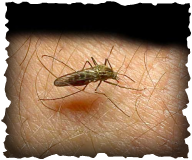
Kills about 2 million people per year
Malaria causes about 400–900 million cases of fever and approximately one to three million deaths annually — this represents at least one death every 30 seconds. The vast majority of cases occur in children under the age of 5 years; pregnant women are also especially vulnerable. Despite efforts to reduce transmission and increase treatment, there has been little change in which areas are at risk of this disease since 1992. Indeed, if the prevalence of malaria stays on its present upwards course, the death rate could double in the next twenty years. Precise statistics are unknown because many cases occur in rural areas where people do not have access to hospitals or the means to afford health care. Consequently, the majority of cases are undocumented.
Malaria causes about 400–900 million cases of fever and approximately one to three million deaths annually — this represents at least one death every 30 seconds. The vast majority of cases occur in children under the age of 5 years; pregnant women are also especially vulnerable. Despite efforts to reduce transmission and increase treatment, there has been little change in which areas are at risk of this disease since 1992. Indeed, if the prevalence of malaria stays on its present upwards course, the death rate could double in the next twenty years. Precise statistics are unknown because many cases occur in rural areas where people do not have access to hospitals or the means to afford health care. Consequently, the majority of cases are undocumented.
Malaria is one of the most common infectious diseases and an enormous public-health problem. It's parasites are transmitted by female Anopheles mosquitoes. The parasites multiply within red blood cells, causing symptoms that include symptoms of anemia (light headedness, shortness of breath, tachycardia etc.), as well as other general symptoms such as fever, chills, nausea, flu-like illness, and in severe cases, coma and death. The disease is caused by protozoan parasites of the genus Plasmodium. It is widespread in tropical and subtropical regions, including parts of the Americas, Asia, and Africa.

 RSS Feed
RSS Feed